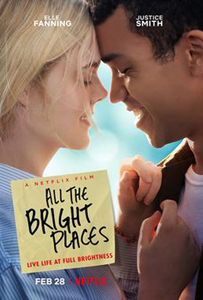“All the Bright Places” (February, Netflix) walks a fine line. For some young viewers, it’ll be the best movie they’ve ever seen; for cynical older viewers, it’ll be a cliché-ridden bore fest. For me, it’s pretty much the best Gen-Z teen romance I’ve seen (Elle Fanning and Justice Smith are late-era millennials, but they play younger than their ages).
There’s always the fear that modern teens will be off-puttingly self-centered and all-knowing, but I liked Fanning’s Violet and Smith’s Finch, and they are quite cute when going through the cliches.
Something refreshing
But for all its familiar beats, there’s something refreshing about “Bright Places.” These teens aren’t buried in their phones and computers; Violet’s notebook journal and Finch’s Post-It notes play prominent roles, and these props don’t feel forced. As the title suggests, life will always be about real places and real memories, no matter how advanced technology gets. Young people love nature and experiences as much as anyone else.

“All the Bright Places” (2020)
Director: Brett Haley
Writers: Jennifer Niven, Liz Hannah
Stars: Elle Fanning, Justice Smith, Alexandra Shipp
“Bright Places” is a throwback in that positive way, but also in one negative way. Finch has a psychological condition wherein he goes away and broods for days, and sometimes has bouts of anger, but he doesn’t get professional help (aside from one group session that does little for him) or prescription drugs. In fact, his precise condition remains a mystery, although there is one big clue: His dad, who has since left him and his sister Kate (“X-Men’s” Alexandra Shipp), used to go into rages and beat his kids.
The simple explanation is that his father is a bad human being, but Finch is curious if there is more to it, especially as he grows more conscious of sharing the man’s DNA. I suspect doctors and nurses might be deeply frustrated by a modern-day film that barely turns an eye toward professional health solutions.
“Bright Places’ ” tragic undercurrents are undeniable, and it has a John Green vibe – complete with loving yet tangential parents (including Luke Wilson here) — although it comes from a 2015 young-adult novel by Jennifer Niven, who co-writes the film with Liz Hannah.
Violet, often with rosy cheeks that make it seem like she cries when the camera’s not on her, has recently lost her older sister in a car accident. All viewers will be thinking “Oh no, poor Dakota,” although a montage of photos shows a different actress.
Manic Pixie Dream Boy
Finch comes in as somewhat of a Manic Pixie Dream Boy who is going to “save” Violet (their meet-cute is on the ledge of a tall bridge), except that the point of view is his. So female viewers can enjoy the angelic savior fantasy and male viewers can relate to that feeling of loving a quiet girl and hoping that she opens up to him.

And then of course we’ll also wish we were as cool as Finch, who is 180 degrees removed from Smith’s nerdy pushover in “Jurassic World: Fallen Kingdom.” Here, the actor has somewhat of a troubled vibe like Hayden Christensen, but with a big heart outshining the scowl.
As for Fanning, we’ve known for some time that she’s a great actress. It’s expected when “Bright Places” pivots to Violet’s POV, and she is tasked with “saving” Finch the way he saved her – but that’s one predictable element that’s welcome.
Director Brett Haley, cinematographer Rob Givens and the location scouting team help “All the Bright Places” live up to its title. We get suitable-for-framing shots like the yellow-haired Violet against a backdrop of golden maple leaves, as mellow troubled-youth tunes play over them. (Finch’s sing-alongs and impromptu dances are among his MPDB traits.)
“Bright Places” is set in Indiana – presumably for the amusing fact that it’s not a place you’d think of as gorgeous, thus setting up the theme that even ugliness can be beautiful.
Beauty from ruins
It’s shot in and around Cleveland, also an ugly place by reputation, and we get some striking locations such as the shell of a brick building that includes a section where people can write out their dreams in chalk.
More genre-requisite quirkiness comes from the “highest point in Indiana” marker (which is not very high), a shoe tree, and a homemade mini-rollercoaster where the teens (and most likely Fanning and Smith themselves) have a blast.
“Bright Places” misses opportunities to achieve classic status. Although Finch is too grounded and connected to people for a viewer to suspect he’s a literal angel or a figment of the girl’s imagination, the film has one mystical element that perhaps should’ve been played up into magical realism.
More outright happiness might’ve been nice too; moments like the delighted rollercoaster laughter are breaks from the foundational tone of sadness rather than the norm.
I think teens – and all viewers – could use some happier films right now. “Bright Places” isn’t totally committed to being that, but it takes steps toward it, and for that I kind of love it.

